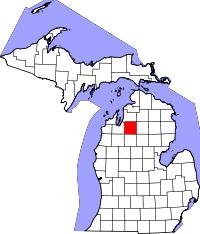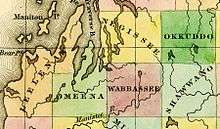Kalkaska County, Michigan
| Kalkaska County, Michigan | |
|---|---|
 Location in the U.S. state of Michigan | |
 Michigan's location in the U.S. | |
| Founded | 1871[1] |
| Seat | Kalkaska |
| Largest village | Kalkaska |
| Area | |
| • Total | 571 sq mi (1,479 km2) |
| • Land | 560 sq mi (1,450 km2) |
| • Water | 11 sq mi (28 km2), 1.9% |
| Population | |
| • (2010) | 17,153 |
| • Density | 31/sq mi (12/km²) |
| Congressional district | 1st |
| Time zone | Eastern: UTC-5/-4 |
| Website |
www |
Kalkaska County is a county located in the U.S. state of Michigan. As of the 2010 census, the population was 17,153.[2] The county seat is Kalkaska.[3]
Kalkaska County is included in the Traverse City Micropolitan Statistical Area. The county is considered to be part of Northern Michigan.
Etymology of the name Kalkaska
The county's name is a pseudo-Native American word coined by Henry Schoolcraft, a Michigan geographer and ethnologist.[4] The name Kalkaska is thought to be a Chippewa word meaning flat or burned-over country. An alternative theory is that this is a neologism or neonym created by Henry Schoolcraft, originally spelled Calcasca. Some theorists suggest this is word play. Schoolcraft's family name had been Calcraft, and the Ks may have been added to make the name appear more like a Native American word.[5]
History

The county was formed in 1840 and called Wabassee County until 1843.[6][7] The first settler in Kalkaska County was an Englishman named William Copeland, who purchased land in the northwest corner of the county in 1855. Logging was the first important industry. The discovery of substantial deposits of oil and natural gas resulted in the construction of a processing plant by Shell Oil Company in 1973 and a major economic boom in the community.
Geography
According to the U.S. Census Bureau, the county has a total area of 571 square miles (1,480 km2), of which 560 square miles (1,500 km2) is land and 11 square miles (28 km2) (1.9%) is water.[8]
Kalkaska Sand, the state soil of Michigan, was named after the county because of the large amounts deposited in the area from the glaciers in the Ice Age.
Kalkaska County has over 80 lakes and 275 miles (443 km) of streams and rivers. Much of the county is marshland. County elevation ranges from 595 feet (181 m) to about 1,246 feet (380 m). This makes it one of the more uneven counties in the Lower Peninsula.
The Pere Marquette State Forest covers much of the county. Glaciers shaped the area, creating a unique regional ecosystem. A large portion of the area is the so-called Grayling outwash plain, which consists of broad outwash plain including sandy ice-disintegration ridges; jack pine barrens, some white pine-red pine forest, and northern hardwood forest. Large lakes were created by glacial action.[9]
Lakes
- Torch Lake
- Starvation Lake
- Lake Skegemog
- Bear Lake
- Manistee Lake
- Grass Lake
- Rainbow Lake
- Blue Lake
- Cub Lake
- Twin Lake
- Little Twin Lake
- Pickerel Lake
- Squaw Lake
- Indian Lake
- Perch Lake
- Crawford Lake
- Lost Lake
- Johnson Rd Lake
- Log Lake
- Selkirk Lake
- Kettle Lake
- Lake Placid
- Sand Lake
- Twenty Eight Lakes
- East Lake
- Long Lake
- Lake Five
- Wheeler Lake
Rivers
Major highways
Adjacent counties
- Antrim County - north
- Otsego County - northeast
- Crawford County - east
- Roscommon County - southeast
- Missaukee County - south
- Wexford County - southwest
- Grand Traverse County - west
Demographics
| Historical population | |||
|---|---|---|---|
| Census | Pop. | %± | |
| 1870 | 424 | — | |
| 1880 | 2,937 | 592.7% | |
| 1890 | 5,160 | 75.7% | |
| 1900 | 7,133 | 38.2% | |
| 1910 | 8,097 | 13.5% | |
| 1920 | 5,577 | −31.1% | |
| 1930 | 3,799 | −31.9% | |
| 1940 | 5,159 | 35.8% | |
| 1950 | 4,597 | −10.9% | |
| 1960 | 4,382 | −4.7% | |
| 1970 | 5,272 | 20.3% | |
| 1980 | 10,952 | 107.7% | |
| 1990 | 13,497 | 23.2% | |
| 2000 | 16,571 | 22.8% | |
| 2010 | 17,153 | 3.5% | |
| Est. 2015 | 17,260 | [10] | 0.6% |
| U.S. Decennial Census[11] 1790-1960[12] 1900-1990[13] 1990-2000[14] 2010-2013[2] | |||
As of the census[15] of 2000, there were 16,571 people, 6,428 households, and 4,634 families residing in the county. The population density was 30 people per square mile (11/km²). There were 10,822 housing units at an average density of 19 per square mile (7/km²). The racial makeup of the county was 98.44% White, 0.21% Black or African American, 0.78% Native American, 0.22% Asian, 0.05% Pacific Islander, 0.10% from other races, 0.86% of the population were Hispanic or Latino of any race. 24.6% were of German, 12.4% English, 10.4% Irish, 10.0% American, 6.3% Polish and 5.1% French ancestry according to Census 2000. 98.8% spoke English as their first language.
There were 6,428 households out of which 31.70% had children under the age of 18 living with them, 58.60% were married couples living together, 9.00% had a female householder with no husband present, and 27.90% were non-families. 22.30% of all households were made up of individuals and 8.20% had someone living alone who was 65 years of age or older. The average household size was 2.55 and the average family size was 2.95.
In the county the population was spread out with 25.60% under the age of 18, 7.60% from 18 to 24, 28.60% from 25 to 44, 24.50% from 45 to 64, and 13.70% who were 65 years of age or older. The median age was 38 years. For every 100 females there were 101.30 males. For every 100 females age 18 and over, there were 98.90 males.
The median income for a household in the county was $36,072, and the median income for a family was $39,932. Males had a median income of $31,860 versus $20,455 for females. The per capita income for the county was $16,309. About 8.20% of families and 10.50% of the population were below the poverty line, including 14.20% of those under age 18 and 7.00% of those age 65 or over.
Government
The county government operates the jail, maintains rural roads, operates the major local courts, keeps files of deeds and mortgages, maintains vital records, administers public health regulations, and participates with the state in the provision of welfare and other social services. The county board of commissioners controls the budget but has only limited authority to make laws or ordinances. In Michigan, most local government functions — police and fire, building and zoning, tax assessment, street maintenance, etc. — are the responsibility of individual cities and townships.
Events
The National Trout Festival is a festival held every year at the end of April. First celebrated in 1936, festivities include a parade, carnival, kids trout fishing contest, demolition derby, rodeo and livestock fair, among other things. It is a time when the community members and businesses come together to celebrate the heritage and sportsmanship of Kalkaska.[16]
Communities
Village
- Kalkaska (county seat)
Townships
Unincorporated places
See also
References
- ↑ "Bibliography on Kalkaska County". Clarke Historical Library, Central Michigan University. Retrieved January 19, 2013.
- 1 2 "State & County QuickFacts". United States Census Bureau. Retrieved August 28, 2013.
- ↑ "Find a County". National Association of Counties. Retrieved 2011-06-07.
- ↑ "Michigan Counties". Michigan.gov. Archive.org. Archived from the original on March 13, 2009. Retrieved 14 February 2016.
- ↑ Michigan History, County Names.
- 1 2 Newberry Library. "Michigan: Individual County Chronologies". Atlas of County Historical Boundaries. Retrieved 2016-11-04.
- ↑ "Clarke Historical Library, Central Michigan University, Bibliography on Kalkaska County". Retrieved 2016-11-04.
- ↑ "2010 Census Gazetteer Files". United States Census Bureau. August 22, 2012. Retrieved September 26, 2014.
- ↑ Michigan regional geology.
- ↑ "County Totals Dataset: Population, Population Change and Estimated Components of Population Change: April 1, 2010 to July 1, 2015". Retrieved July 2, 2016.
- ↑ "U.S. Decennial Census". United States Census Bureau. Retrieved September 26, 2014.
- ↑ "Historical Census Browser". University of Virginia Library. Retrieved September 26, 2014.
- ↑ "Population of Counties by Decennial Census: 1900 to 1990". United States Census Bureau. Retrieved September 26, 2014.
- ↑ "Census 2000 PHC-T-4. Ranking Tables for Counties: 1990 and 2000" (PDF). United States Census Bureau. Retrieved September 26, 2014.
- ↑ "American FactFinder". United States Census Bureau. Retrieved 2008-01-31.
- ↑ National Trout festival, and picture of 'the trout.'
Further reading
- Kalkaska Genealogical Society: Big Trout, Black Gold: History of Kalkaska County, Michigan. nd.
External links
- Kalkaska County government
- Kalkaska County Sheriff's Office
- Village of Kalkaska
- Kalkaska Memorial Health Center
- Kalkaska Chamber of Commerce
- Kiwanis Club of Kalkaska
- Michigan Heritage & Research Foundation
- National Trout Festival
- Historical Society of Kalkaska
- Kalkaska Visitors Guide
- Watershed Center Grand Traverse Bay
 |
Lake Michigan | Antrim County | Otsego County |  |
| Grand Traverse County | |
Crawford County | ||
| ||||
| | ||||
| Wexford County | Missaukee County | Roscommon County |
Coordinates: 44°41′N 85°05′W / 44.69°N 85.08°W